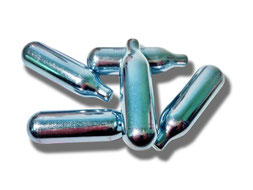Nitrous oxide
Name:
Laughing gas, nitrous oxide, N2O, nitrous, hippie crack
Effects:
Euphoria, 'high' feeling, laughing, distortion of sound, pain relief
Side effects:
Intoxication, spatial and temporal disorientation, muscle spasms and vocalisations (rare). Fainting.
Vitamine B12 deficiency: subacute combined degenerative neuropathy secondary to B12 inactivation. (2)
While relatively non-toxic, nitrous oxide has a number of recognized ill effects on human health, whether through breathing it in or by contact of the liquid with skin or eyes.
Nitrous oxide is a significant occupational hazard for surgeons, dentists, and nurses. Because nitrous oxide is minimally metabolised in humans (with a rate of 0.004%), it retains its potency when exhaled into the room by the patient, and can pose an intoxicating and prolonged exposure hazard to the clinic staff if the room is poorly ventilated
Mechanism of action:
The analgesic effect of N2O appears to be initiated by stimulated neuronal release of endogenous opioid peptides, with subsequent activation of opioid receptors and descending GABA and noradrenergic pathways that modulate nociceptive processing at the spinal level. The anxiolytic effect of N2O involves activation of the GABA-A receptor through the benzodiazepine binding site, although whether N2O acts directly or indirectly upon the latter targets remains uncertain. The anxiolytic pathway that is stimulated includes a segment that involves a sequence of 3 key enzymes, NOS, soluble guanylyl cyclase, and PKG. The anesthetic effect of N2O appears to be caused by inhibition of NMDA glutamate receptors and removing its excitatory influence in the nervous system. (2)
The effects of nitrous oxide are almost instantaneous upon inhalation and last up to several minutes.
Nitrous oxide causes its harmful effects by irreversibly oxidising the cobalt ion of cobalamin (vitamin B12) from the (+) 1 to the (+) 3 valence state. In the normal state after gastrointestinal absorption, the transcobalamin-cobalamin complex is degraded and cobalamin II is released for conversion into the active forms of vitamin B, methylcobalamin, and adenosylcobalamin. Oxidation of the cobalt ion by nitrous oxide prevents methylcobalamin from acting as a co- enzyme in the production of methionine and subsequently S-adenosylmethionine, which is necessary for methylation of myelin sheath phospholipids.

Substance and dosage:
Nitrous oxide comes in gas canisters and contains roughly 8 grams per canister, or 4.3 litres in atmospheric pressure.
Nitrous oxide has numerous medical uses as an anaesthetic and analgesic in surgery and dentistry. Nitrous oxide used for medical purposes is mixed with pure oxygen, making it suitable for human consumption. Recreationally used nitrous oxide is used in pure form by filling balloons with it and inhaling them.
Average recreational use is less than 10 balloons on one occasion.
Overdosage:
Usually fainting.
Nitrous oxide induced vitamine B12 deficiency may be treated with intramuscular injections of 1,000 µg vitamin B12 (cyanocobalamin) daily for 1 week, followed by weekly injections for 4–8 weeks, and then monthly injections until clinical resolution; or daily oral administration of 1,000–2,000 µg cyanocobalamin until clinical resolution. (3)
(1) Neurological complications of nitrous oxide abuse http://www.bcmj.org/sites/default/files/BCMJ_Vol58_No4_nitrous_oxide.pdf
(2) Advances in understanding the actions of nitrous oxide https://www.ncbi.nlm.nih.gov/pmc/articles/PMC1821130/pdf/i0003-3006-54-1-9.pdf
(3) Recreational Nitrous Oxide Abuse-Induced Vitamin B12 Deficiency in a Patient Presenting with Hyperpigmentation of the Skin
https://www.ncbi.nlm.nih.gov/pmc/articles/PMC3724136/pdf/cde-0005-0186.pdf
